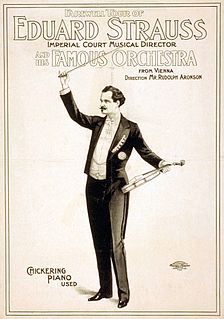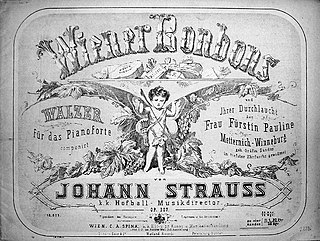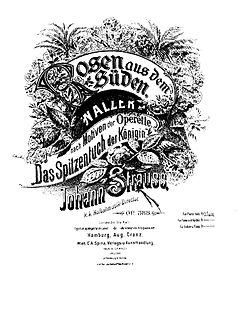Related Research Articles

Johann Strauss II, also known as Johann Strauss Jr., the Younger, the Son, was an Austrian composer of light music, particularly dance music and operettas. He composed over 500 waltzes, polkas, quadrilles, and other types of dance music, as well as several operettas and a ballet. In his lifetime, he was known as "The Waltz King", and was largely responsible for the popularity of the waltz in Vienna during the 19th century. Some of Johann Strauss's most famous works include "The Blue Danube", "Kaiser-Walzer", "Tales from the Vienna Woods", and the "Tritsch-Tratsch-Polka". Among his operettas, Die Fledermaus and Der Zigeunerbaron are the best known.

Johann Strauss I was an Austrian Romantic composer. He was famous for his waltzes, and he popularized them alongside Joseph Lanner, thereby setting the foundations for his sons to carry on his musical dynasty. He is best known for his composition of the Radetzky March.

Josef Strauss was an Austrian composer.

"The Blue Danube" is the common English title of "An der schönen, blauen Donau", Op. 314, a waltz by the Austrian composer Johann Strauss II, composed in 1866. Originally performed on 15 February 1867 at a concert of the Wiener Männergesangsverein, it has been one of the most consistently popular pieces of music in the classical repertoire. Its initial performance was considered only a mild success, however, and Strauss is reputed to have said, "The devil take the waltz, my only regret is for the coda—I wish that had been a success!"

Eduard "Edi" Strauss was an Austrian composer who, together with his brothers Johann Strauss II and Josef Strauss made up the Strauss musical dynasty. He was the son of Johann Strauss I and Maria Anna Streim. The family dominated the Viennese light music world for decades, creating many waltzes and polkas for many Austrian nobility as well as dance-music enthusiasts around Europe. He was affectionately known in his family as 'Edi'.

Wiener Bonbons op. 307 is a waltz by Johann Strauss II written in 1866. It was first performed on 28 January 1866 at the ball of the Association of Industrial Societies held in the Redoutensaal and was dedicated to the influential Princess Pauline Metternich-Winneburg the wife of then Austrian ambassador to Paris.

Joseph Lanner was an Austrian dance music composer and dance orchestra conductor. He is best remembered as one of the earliest Viennese composers to reform the waltz from a simple peasant dance to something that even the highest society could enjoy, either as an accompaniment to the dance, or for the music's own sake. He was just as famous as his friend and musical rival Johann Strauss I, who was better known outside of Austria in their day because of his concert tours abroad, in particular, to France and England.
"Die Publicisten" is a waltz by Johann Strauss II composed in 1868. It was written for the sixth Concordia Ball held in the Sofienbad-Saal on the 4 February of the same year. The waltz's title was an allusion to Vienna's press, with whom he maintained a fruitful partnership that his family had enjoyed since the days of his father Johann Strauss I. The more or less symbiotic association was needed as the musical business of composers would inevitably flourish under favorable press reviews and the establishment of the Vienna Journalists' and Authors' Association in 1859 would signify an even more closer relationship between both composer and the press. The Concordia Ball named after the Roman God of civic concord had its first ball in 1863.

Carl Michael Ziehrer was an Austrian composer. In his lifetime, he was one of the fiercest rivals of the Strauss family; most notably Johann Strauss II and Eduard Strauss.
Liebeslieder op. 114 is a waltz by Johann Strauss II written in 1852. At the time it was conceived, the waltz was titled 'Liebesgedichte' or "Love Poems" and during its first performance, it was even announced as 'Liebesständchen' or "Love Serenade". The first performance was at the famed Vienna Volksgarten on 18 June 1852 under the composer's direction.

Rosen aus dem Süden, Op. 388, is a waltz medley composed by Johann Strauss II in 1880 with its themes drawn from the operetta Das Spitzentuch der Königin inspired by a novel by Heinrich Bohrmann-Riegen.
Immer heiterer op. 235 is a waltz written by Johann Strauss II in 1860 for the Vienna Carnival Fasching. The waltz was marked as "im ländlerstil" which meant that it was to be performed in the same style as the ländler.
Bürgersinn op. 295 is a waltz by Johann Strauss II composed in 1865 for the Citizen's Ball held during the Vienna Carnival Fasching of the year. His prestigious post of the 'KK Hofballmusikdirektor', which he attained in 1863, meant that his responsibilities included composing dance music for these functions.
Im Krapfenwald'l op. 336 is a polka by Johann Strauss II written in 1869 and was originally titled 'Im Pawlowsk Walde' when first performed in Pavlovsk on 6 September 1869. Reportedly, several encores of the piece was called for and Strauss felt moved to retitled the piece to suit his audience back in native Vienna.

Wiener Blut Op. 354 is a waltz by Johann Strauss II first performed by the composer on 22 April 1873. The new dedication waltz was to celebrate the wedding of the Emperor Franz Joseph I's daughter Archduchess Gisela Louise Maria and Prince Leopold of Bavaria. However, the waltz was also chiefly noted by Strauss' biographers as the début of Strauss with the Vienna Philharmonic Orchestra where for many years, the Philharmonic had dismissed any association with the 'Waltz King' as it had not wished to be associated with mere 'light' or 'pops' music. The festival ball celebrating the event was held at the Musikverein Hall which is the venue for the present day Neujahrskonzert.
Neu Wien , opus 342, is a waltz written by Johann Strauss II in 1870 and dedicated to Nicolaus Dumba (1830-1900), who was a fervent patron of Arts and was the Chairman of the Wiener Männergesang-Verein and Vice-President of the Gesellschaft der Musikfreunde in Wien.
Vergnügungszug op. 281 is a polka composed by Johann Strauss II in 1864. It was written for the Association of Industrial Societies' Ball held in the Redoutensaal on 19 January 1864 and was inspired by the opening of the Austrian Southern Railway – the Südbahn – which operated many 'pleasure trains' offering trips from Vienna to the countryside.

Wiener Blut is an operetta named after the "Wiener Blut" waltz, supposedly with music by the composer Johann Strauss the Younger, who did not live to witness the première. Such was the popularity of the original "Wiener Blut" Op. 354 waltz until the time of the composer's death that his work would be chosen as the name of the operetta with libretto by Victor Léon and Leo Stein set around the Vienna Congress of 1814 to 1815.
Abschied von St. Petersburg, opus 210, is the name of a waltz composed by Johann Strauss II. The work was first performed at a benefit concert in Pavlovsk on September 5, 1858, as part of a tour of Russia that Strauss was conducting. In keeping with the vogue then current in Russia for the French language, the work was entitled as Mes adieux à St. Pétersbourg. Less than a week after his return to his home city of Vienna, Strauss conducted the first Viennese performance of the work at the Vienna Volksgarten.
References
Based on original text by Peter Kemp, The Johann Strauss Society of Great Britain. Used with permission.